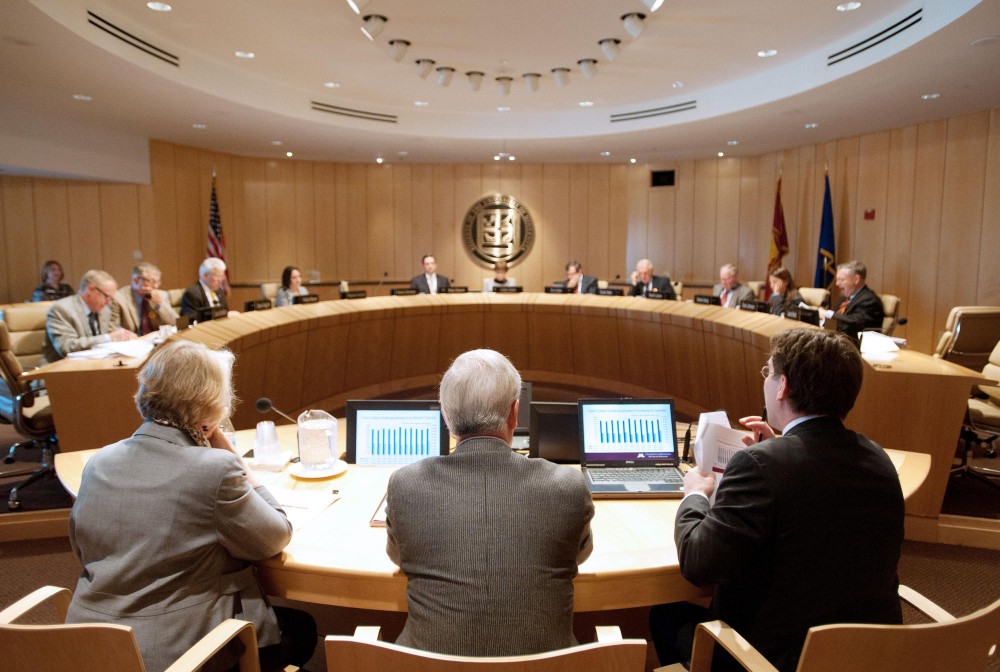The University of MinnesotaâÄôs Board of Regents finalized its wish list of projects for the state, missing one long-awaited project: the ambulatory care clinic.
The board shelved its plan to fund the $200-million clinic at its meeting Friday, which would consolidate medical facilities scattered across campus and relieve the burden on the overcrowded Phillips Wangensteen Building.
In the last two weeks, it became evident that the University wasnâÄôt ready to move forward with its $100-million share of the cost, Chief Financial Officer Richard Pfutzenreuter said. Though the state generally pitches in for two-thirds of construction costs at the University, the bill was set to be split 50-50.
The future of reimbursement, the price of prescription drugs, employee management and the hospitalâÄôs classification didnâÄôt come together in time to be approved this month, according to Pfutzenreuter.
âÄúThe financing of medical care in this country is extremely complicated,âÄù he said.
The ambulatory clinic was listed second on the boardâÄôs prioritized bonding request in September. Despite its importance, itâÄôs not the projectâÄôs first delay.
Six years ago, the University partnered with Fairview Health Services and University of Minnesota Physicians to try to build the center, Kathleen OâÄôBrien, vice president of University Services, previously told the Daily. The group put the plan on pause in 2008 due to the recession and because other attempts to get alternate funding were foiled.
The fact that the University and Fairview Clinics would need a new facility has been acknowledged since the two groups first partnered in the âÄô90s, Pfutzenreuter said.
âÄúWeâÄôre at the point where [Phillips Wangensteen] is old âÄî not conducive to the needs of patients and the ability to educate medical students,âÄù Pfutzenreuter said, describing them as âÄútired and difficult to get to.âÄù
âÄúThereâÄôs no one building for the Medical School at the U,âÄù said Phillip Radke, president of the University of Minnesota Medical Student Council. Despite the aging facilities, Radke thinks the patient loads in the medical facilities are pretty well managed.
The cut reduces the UniversityâÄôs capital request from a total of $270 million to $170 million âÄî more in-line with the $200 million the University generally requests in even-numbered years, OâÄôBrien said.
In light of an uncommonly large $500 million bonding bill passed in the summerâÄôs special session, regents Laura Brod and Steve Sviggum, both former state legislators, said trimming the UniversityâÄôs request was a wise move.
After the summer bonding bill, there isnâÄôt a whole lot left over in the two-year budget for 2012, Sen. David Senjem, R-Rochester, said in a September interview. Senjem, who chairs the SenateâÄôs Capital
Investment Committee, predicted the UniversityâÄôs share of a 2012 bonding bill would near the $133-million mark.
âÄúI think the amount we have here is a reasonably prudent amount [to request] from the Legislature,âÄù Sviggum said, emphasizing the need to keep Higher Education Asset Preservation and Replacement funds a top priority.
HEAPR funds allow the University to maintain, renovate and retrofit buildings on campus. As he stressed the importance of the maintenance funding, Regent David Larson said that deferring maintenance would only cost the University and the state more money.
âÄúWe get around to [maintaining] every square foot about every 30 years,âÄù Regent Clyde Allen said.
The request finalized at FridayâÄôs meeting includes $90 million for HEAPR and funding for an Old Main Utility Building renovation, Itasca facilities improvements, Eddy Hall renovations and space optimization and an American Indian Learning Resource Center on the Duluth campus.
The University plans to restructure financing for the Ambulatory Care Clinic and bring it up again in the future.
Pfutzenreuter said heâÄôll be looking for âÄúcreative waysâÄù to fund the clinic. ItâÄôs been done before, as in the case of TCF Bank Stadium, by combining corporate naming right funds, land sales, state support and private donations.
President Eric Kaler emphasized the need for the new medical facility, insisting it was still on the table.
âÄúWeâÄôre still involved in very vigorous discussions with Fairview,âÄù he said.









